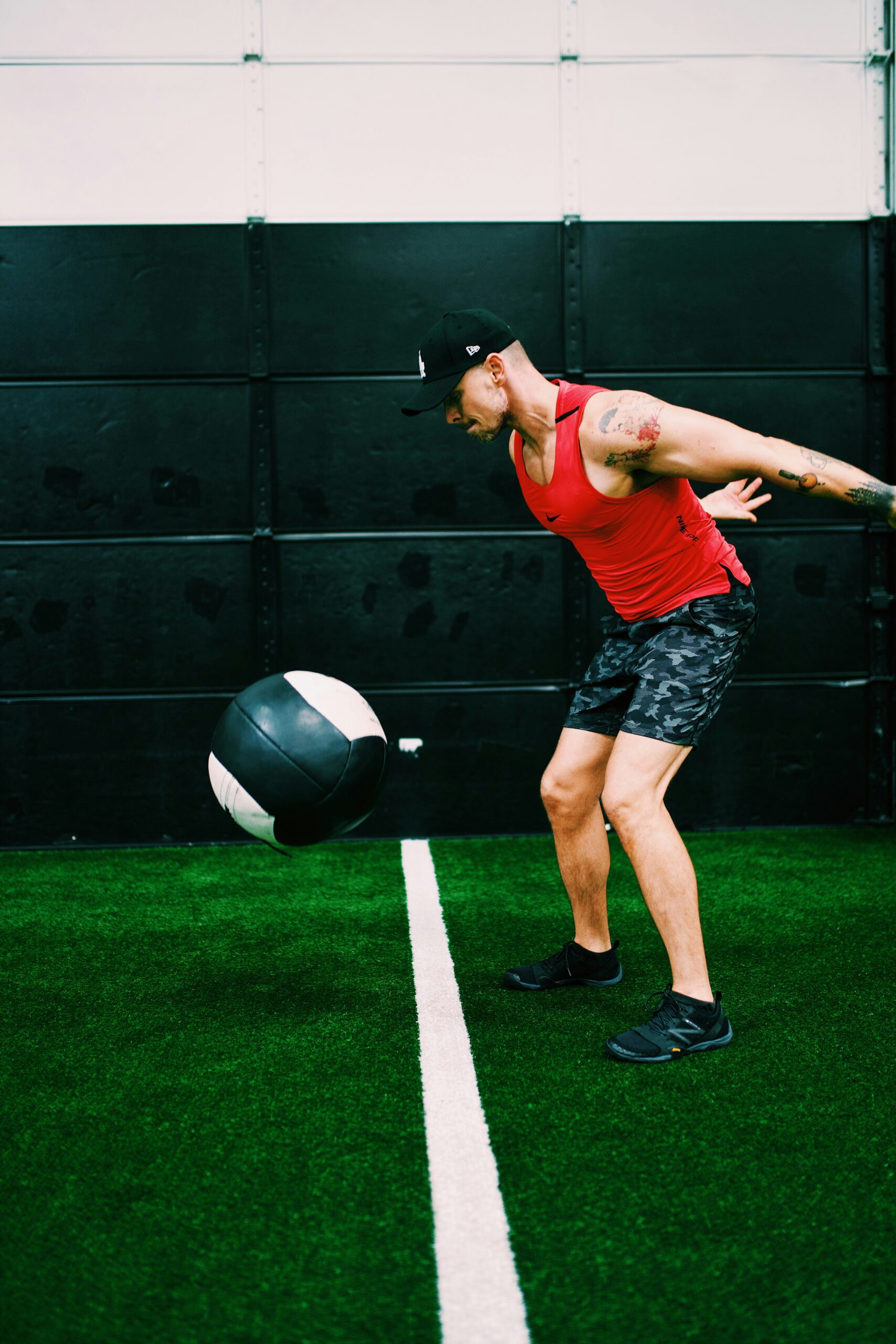Rotational speed is crucial for athletes in sports that require twisting, turning, and powerful torso movement. Whether you’re throwing a baseball, taking a tennis swing, or cutting on the soccer field, your ability to rotate quickly and powerfully determines your performance.
Medicine-ball drills are one of the most effective ways to develop rotational strength and speed. These exercises train your core muscles to generate force in rotational patterns that directly transfer to athletic movements. Unlike traditional core exercises that only work in straight lines, medicine-ball drills challenge your body in the same twisting motions you use during competition.
This guide covers the most effective medicine-ball drills for building rotational speed, proper setup and safety tips, and how these exercises improve your athletic performance. With consistent training and proper technique, you’ll develop the explosive rotational power that gives you an edge in competition.
Why Rotational Speed Matters for Athletes
Sport-Specific Applications
Rotational speed is fundamental in numerous sports. Baseball and softball players need it for batting and throwing. Tennis players rely on rotational power for serves and groundstrokes. Soccer players use it for shooting and passing. Football players need it for throwing, tackling, and changing direction quickly.
The faster you can rotate your torso, the more power you can generate in these movements. A baseball player who can rotate quickly generates more bat speed. A tennis player with good rotational speed hits harder serves and groundstrokes.
Athletes who develop superior rotational speed often stand out from their competition because this quality is frequently overlooked in training programs that focus only on linear movements.
Power Generation and Direction Changes
Rotational movements create a kinetic chain that transfers energy from your core to your limbs. When you throw a ball or swing a bat, power starts in your legs, travels through your core via rotation, and transfers to your arms and hands.
Quick rotational ability also improves your capacity to change directions rapidly. The ability to twist your torso quickly while keeping your hips stable allows for sharper cuts and more explosive direction changes that leave opponents behind.
Athletes with poor rotational speed often compensate by using only their arms or legs, which limits their power output and increases injury risk.
Core Strength
Your core muscles are the foundation of rotational speed. These muscles include not just your abs, but also your obliques, lower back muscles, and deep stabilizers that control spine movement.
Strong core muscles provide the stable platform needed for explosive rotation while protecting your spine from injury. When your core is weak, other muscles try to compensate, leading to inefficient movement patterns and increased injury risk.
Medicine-ball training builds functional core strength that translates directly to sports performance rather than just making your abs look good.
Preparing for Medicine-Ball Training
- Warm Up Your Core and Torso: Always start with 10-15 minutes of dynamic warm-up focused on the torso and core muscles. Include torso twists, arm circles, leg swings, and light rotational movements to prepare your spine for explosive training. Cold muscles and joints are much more susceptible to injury during rotational movements.
- Choose Appropriate Medicine Ball Weight: Start with a ball that’s challenging but allows perfect form throughout all reps. For most youth athletes, 4-8 pounds works well, while adults can typically handle 8-15 pounds. You should be able to move the ball explosively while maintaining control. Too heavy leads to slow, grinding movements that don’t develop speed.
- Focus on Control and Form: Rotational exercises can be dangerous if performed with poor technique. Always maintain a neutral spine position and avoid excessive twisting at the end ranges of motion. Start each drill slowly to learn the movement pattern before adding speed and power.
- Safe Training Surface: Perform these exercises on a surface with good traction to prevent slipping during explosive movements. Grass, rubber gym flooring, or athletic mats all work well. Avoid slippery surfaces that could cause you to lose balance during rotational movements.
Effective Medicine-Ball Drills for Rotational Speed
Seated Russian Twists
Sit on the ground with knees bent and feet slightly off the floor. Hold the medicine ball at chest level and rotate your torso from side to side, touching the ball to the ground on each side. Keep your chest up and avoid rounding your back.
This exercise builds rotational endurance and control while teaching proper core activation patterns. The seated position eliminates the legs from the movement, forcing your core to do all the work.
Start with 3 sets of 15-20 touches per side. Focus on controlled movement and maintaining good posture throughout. Progress by increasing reps or using a heavier ball.
Standing Medicine Ball Rotational Throws
Stand sideways to a wall about arm’s length away. Hold the medicine ball at chest level, rotate away from the wall, then explosively rotate and throw the ball into the wall. Catch the ball on the rebound and immediately begin the next rep.
This drill develops explosive rotational power that directly transfers to throwing and striking movements. The explosive nature trains your nervous system to generate maximum force quickly.
Perform 3 sets of 8-12 throws per side with 90 seconds rest between sets. Focus on maximum effort on each throw while maintaining balance and control.
Medicine Ball Woodchoppers
Start with the ball overhead on one side of your body. Explosively bring the ball down across your body toward the opposite hip, rotating your torso and pivoting on your feet. Return to the starting position with control.
This exercise mimics the rotational pattern used in many sports while building strength through a full range of motion. The diagonal movement pattern challenges your core in multiple planes simultaneously.
Complete 3 sets of 10-12 reps per side. Focus on smooth, powerful movement while keeping your core engaged throughout the entire range of motion.
Rotational Slams
Hold the medicine ball overhead and rotate your torso to one side. Explosively slam the ball down toward the ground on the opposite side of your body, using your entire core to generate force. Pick up the ball and repeat on the other side.
This drill combines rotational power with explosive strength, making it excellent for developing the type of power needed for striking and throwing movements.
Perform 3 sets of 6-10 slams per side with 2 minutes rest between sets. Focus on maximum effort while maintaining good posture and control throughout the movement.
Training Guidelines
Frequency: Perform rotational medicine-ball training 2-3 times per week with at least one rest day between sessions. These exercises are demanding on your core and nervous system.
Sets and Reps: For power development, use lower reps (6-12) with maximum effort. For endurance, use higher reps (15-25) with moderate intensity. Always prioritize quality over quantity.
Rest Periods: Take 90 seconds to 2 minutes rest between sets for explosive exercises, 60 seconds for endurance-focused exercises. Full recovery ensures you can maintain maximum effort on each set.
Progression: Increase difficulty by adding reps, using heavier balls, or increasing throwing velocity rather than jumping to much heavier weights quickly.
Conclusion
Rotational speed is a key element in many sports, and medicine-ball drills offer a practical way to develop this power safely and effectively. These exercises train your core muscles in the same patterns you use during competition, creating strength and speed that directly transfer to better performance.
Regular training with these exercises strengthens your core muscles and enhances your ability to generate quick, powerful rotations during play. The key is consistency and proper technique—focus on perfect form and gradual progression rather than trying to rush results.
For athletes looking to advance their rotational speed and overall athleticism, personalized coaching can provide valuable insight and tailored programs. Athletes Untapped connects you with expert trainers who specialize in sport-specific strength and conditioning. With the right guidance, you’ll build power and agility that make a real difference in competition.




